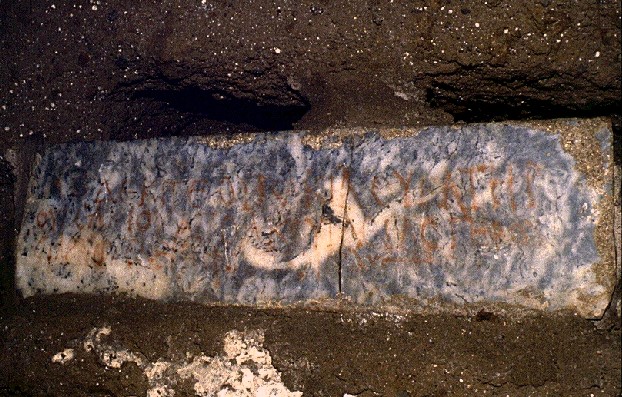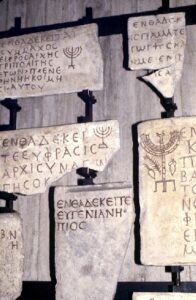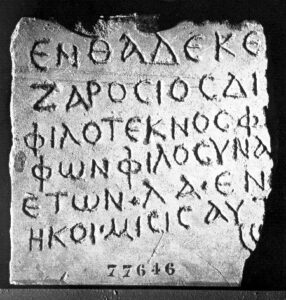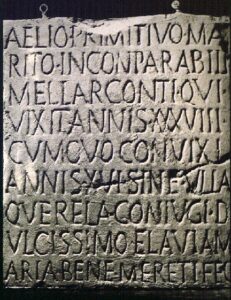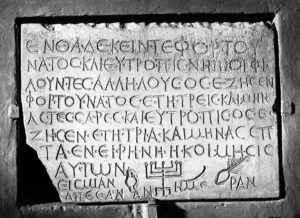Excerpt from: Estelle Shohet Brettman, Vaults of Memory: The Roman Jewish Catacombs and their Context in the Ancient Mediterranean World, rev. ed. Amy K. Hirschfeld, Florence Wolsky, & Jessica Dello Russo. Boston: International Catacomb Society, 1991-2017 (rev. ed. 2024).
Inscriptions from the catacombs of Rome have yielded the single largest corpus of information yet found concerning Jews in ancient Rome.[i] In addition to furnishing information on the language and the names of Roman Jews, the epitaphs from the Jewish catacombs give evidence on the origins as well as the civic and congregational activities of the members of the community, specifically, glimpses into their personalities, vocations, and family and community relationships.
Greek was the lingua franca of the Mediterranean area at this time and prevailed as the language of Jewish liturgy in the Diaspora. It seems to have predominated also in the epitaphs in Jewish catacombs of Rome (although much of the evidence to this point is no doubt missing or not identified as Jewish). More than three-quarters of the epigraphy traced back to the Monteverde catacomb was in Greek, as were most of the surviving epitaphs from the Torlonia burial grounds. There was also some use of Aramaic and Hebrew in those catacombs, but none recorded in that of Vigna Randanini.
A few inscriptions were bilingual. In Monteverde, for instance, four were written in Latin and Greek, three in Greek and Hebrew, and one in Aramaic and Greek. On some bilingual stones, the entire epitaph was repeated in the second language; in others, the inscription was in Greek with added phrases such as "Peace" or "Peace upon Israel" in Hebrew characters. Whatever the language, many stones bore Jewish symbols, sometimes inserted into the body of the text.
Inscriptions in the Jewish catacombs that were not written in Greek were mainly in Latin, with some Latin epitaphs transliterated and inscribed in Greek letters. Latin became the dominant language of Rome's Christians by the mid-fourth century.[ii]
Most of the well-documented Semitic epigraphy was found in Monteverde, and probably originated there.[iii] The American Classicist Harry Leon, who began his study of Rome’s Jewish catacombs around 1920, believed that since the Monteverde grave markers also included the largest number of Semitic names, this catacomb may have been the final resting place for Roman Jews who were recent immigrants, or for who might have had the strongest memory of their ethnic roots and were the most conservative in their outlook on Jewish identity. Yet by the end of the 20th century, another scholars of the Jewish catacombs, Leonard V. Rutgers, took a different approach to the numbers and concluded that there are not enough statistical differences in the relative use of languages and ethnic names in the epitaphs to justify drawing conclusions about the relationships of the various congregational groups to the Roman world around them.[iv]
Greek predominated even in the Randanini catacomb, though with a substantially larger number of Latin epitaphs and Greco-Roman symbols found there than were found in the Monteverde and Torlonia cemeteries. Still, the Jews buried in Randanini need not have been the most "Romanized" of those interred in the four most extensive Jewish catacombs. For one thing, as Rutgers has pointed out, the uncertain dates for the epitaphs mask the possibility for observing any trends in the usage of language and names over time.[v]
In spite of the widespread use of the Greek language, Latin names were generally preferred by the Roman Jews, and exceeded the total number of Semitic and Greek names among them.[vi] Yet many names simply were Hellenized or Latinized versions of Semitic names: Gelasios and Hilaros were equivalents for Isaac (meaning "laughter"); Zosimos for Chayim ("life"); Theodotos for Jonathan ("gift of God"); Iustus for Zadok ("the just"); Donatus and Dativus for Nathan ("given"); Aster for Esther ("star"); Eirene or Irene for Shelomith ("peace"); Annia for Anna ("Hannah"); and Regina for Malcah ("queen"). It is interesting to note that women's tombstones show a higher incidence of Latin names than those of the males; perhaps the girls' parents were more open to naming their daughters according to the prevailing fashions.
Among the Semitic inscriptions is a late (likely fifth century) trilingual memorial to Tobias Barzaharona and his son, unearthed from the bank of the Tiber in 1842.[vii] In Greek, it reads: "Here lies Tubias Barzaharona and Paregorios son of Tubias Barzaharona." The Latin version which follows the Greek is its exact equivalent. A closing invocation is in Hebrew: "Peace, peace, peace, peace," with a menorah after the first and before the last" shalom. " with a leaf at the center of the line.[viii] The name of the deceased is Semitic; his son's name, Paregorios, is the Greek equivalent of Menahem or Nehemiah, meaning "comforter." Punctuating the Greek and Latin texts are grape or ivy leaves, signifying life eternal, popular as well in Christian and polytheisitic funerary contexts. This epitaph is unique in Judeo-Roman epigraphy for its use of a Semitic name in conjunction with both Greek and Latin, and for the repetition of shalom four times.
Epitaph written in Greek and Latin with Hebrew acclamations (JIWE 2.539). National Roman Museum inv. n. 67679 (DAPICS n. 3279).
For the sake of comparison, in the Jewish catacombs in Venosa in Southern Italy, which remained in use well into the Byzantine era, Greek inscriptions substantially outnumber the Latin, yet most of the names are Latin, and of the rest, there are more Semitic names than Greek. Not surprisingly, there are more non-Jewish names in the Diaspora than in Palestine, and in Aphrodisias in Asia Minor, Rutgers has observed an "exceptional" predominance of biblical names for the Jews.[ix]
To put Jewish name practices into context, from the end of the Republican era, ancient Roman citizens customarily carried three names: the praenomen, (first and distinguishing name); nomen gentilicium (the name of the clan or family group, the gens) and an additional name, the cognomen (a surname or nickname), but the practice is unusual for the Roman Jews of later centuries who are named in catacomb inscriptions.[x] Most of the Jews with Latin or Greek names bore only single names, but some had double or even, like Lucius Domitius Abbas, triple names.[xi] It has been suggested that freed slaves (libertini) adopted the gentilicium of their former owners, with each freedman keeping his original name as a cognomen, a practice which might have been perpetuated by their descendants.[xii] Leon, however, who conducted extensive studies of the nomenclature of Jews in Ancient Rome, felt this explanation "far from satisfactory".[xiii] Many Jews who were enslaved during the bitter campaigns waged against Judea by Pompey and by Vespasian and Titus were freed by Roman "patrons" or erstwhile masters and/or with funds provided by their co-religionists who regarded this as a duty. This could be one factor influencing the low headcount of Jewish slaves recorded in Rome.
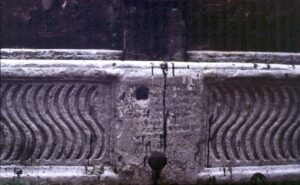
Marble sarcophagus now in a courtyard of the Palazzo Spada. Rome. The inscription reads in Latin "Iul(iae) Irene Aristae m(at (ri) pe)r Dei virtute(m e)t Fidem sationis conservatae iuste legem colenti Atronis Tullianus Eusebius v(ir) o(ptimus) filius pro debito obseq(uio ann (orum)) XLI". " To Julia Irene Arista, his mother, preserved through the power of God and the devotion of her family, a pious observer of the Law Atronius Tullianus Eusebius, vir optimus, her son, in due tribute, aged 21" (DAPICS n. 2146).
As noted above, more of the Jewish girls were given Latin names than the boys, and more frequently, double names, as was customary for Roman women. That said, it was still rare for a Roman Jewess to have three names, although there were a few; two inscriptions which have been cited as examples are the epitaph of Julia Irene Arista[xiv] and a memorial of the Maecius family[xv] on which Lucia Maecia Sabbatis is listed.[xvi] But Julia's sarcophagus, now in Palazzo Spada, is believed to have been found in the church of Sant' Agnese on the Via Nomentana; and in the three generations of the Roman family whose names were included on Lucia's monument, she bore the only name, "Sabbatis," which might be considered Semitic.[xvii]
The use of patriarchal or biblical names was rare in the Roman Jewish community. One Isaac and one Jacob were memorialized, but no one seems to have been named Abraham or Israel.[xviii] In the sixteenth century, an epitaph was recorded for a Beturia (Veturia) Paulina or Paulla, who had assumed the name "Sara" upon becoming a proselyte to Judaism at the age of 70.[xix]
Many inscriptions retrieved from the Jewish catacombs indicate the places of origin of the deceased. Broadly speaking, it has been estimated that of the eight million Jews who may have formed almost 10 percent of the population of the early Roman Empire, one hundred thousand lived in Cyrenaica (Libya), one million in Egypt (forty percent of the population of Alexandria may have been Jewish), two and a half million in Palestine, one and a half million in Asia Minor and Syria together, and one hundred thousand in Italy, of which number there were approximately forty to fifty thousand lived in Rome. Of the remainder of Jews populating the world at that time, about one million are thought to have lived outside of the Roman Empire, mostly in Babylon and Parthia.[xx] Many of the Jewish inscriptions from Rome presumed to be among the oldest in the corpus seem to have originated in the Monteverde catacomb. One of those was for a Hebrew named Makedonis, son of Alexander.[xxi] Like many of his compatriots, he came from Caesarea, a major port and capital of Roman and Byzantine Palestine. His name is an example of the Hellenistic influence on the names of Jews of Caesarea. His epitaph ends with the exhortation, "The memory of the righteous is for a blessing": a reference to Proverbs l0:7, perhaps carrying overtones of moral judgment. Another inscription from Rome, from the Villa Torlonia catacomb, identifies Eusebis as the wife of a Cesarean, Gelasios,[xxii] also concluding with the term "blessing".
Epitaph to Makedonis, son of Alexander, who came from Caesarea, a major port and capital of Roman and Byzantine Palestine (JIWE 2.112). Vatican Museums (DAPICS n. 3305).
Another epitaph from Monteverde, for "Ionios, also named Acone of Sepphoris",[xxiii] was inscribed on the back of a stone which had been used before for someone else.[xxiv] The reuse of tombstones was not an unusual practice; such a stone, inscribed on both sides, is called an "opistograph." Sepphoris, the home of Ionios, was the administrative capital of Hasmonean Galilee in the early first century B.C.E. under the rule of Alexander Jannaeus (Yannai). In the early third century C.E., during the period of the Patriarchate of Rabbi Judah Ha-Nassi, and through the time of his grandson, it became the seat of the Sanhedrin, the supreme governing body of ancient Israel, and successor to the ruling Council of Elders. The Sanhedrin administered the religious, political, and juridical affairs of the Hebrew people during the Roman period before and after the destruction of the Temple of Jerusalem.
Epitaph to Ionios, also named Acone of Sepphoris (JIWE 2.60). Vatican Museums (DAPICS n. 3295).
Alypius of Tiberias was buried in Monteverde with his sons, Iustus and Alypius.[xxv] This émigré from Tiberias, the second capital of Antipas in Galilee, bore a Greek name; one son had a Latin name and the other had the same Greek name as his father. The Jews of the Roman world were apparently not averse to naming a child for a living parent, a custom unlike that amongst most modern Eastern European and American Jews.[xxvi]
Epitaph to Alypius of Tiberias (JIWE 2.561). National Roman Museum (DAPICS n. 3313).
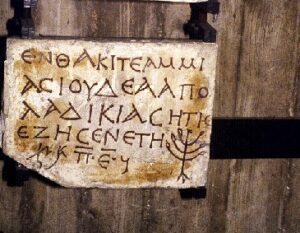
Detail of a marble inscription (Frey #296, Noy #183) In Greek and Hebrew: "Here lies Ammias, a Jewess from Laodicea, who lived 85 years. Peace." With a menorah bottom right (DAPICS n. 1936).
A menorah ornaments the lower right side of a tombstone for "...Ammias, a Jewess of Laodicea, who lived eighty-five years. Peace." It is uncertain whether Laodicea refers to the Syrian coastal city, Laodicea ad Mare, or the inland metropolis in ancient Phrygia; likewise, the last phrase, while recognized as the expression "peace", has been subject to scrutiny, as it seems to incorporate both Aramaic and Nabatean characters.[xxvii]
Memorialized on another tombstone from the Monteverde catacomb was "Symmachos, gerousiarch of Tripolis, aged 80. In peace his sleep."[xxviii] Symmachos had emigrated from Tripolis, either the city located in what is today Libya, or the similarly-named city in Lebanon.[xxix] Both cities had important Jewish communities and commercial contacts with Rome. Whichever the parent city was, Symmachos may have been an officer in the synagogue there, but since a synagogue in Rome also bore the name Tripolitans, he might have been a member of the Council of Elders which governed the Roman congregation. He lived a long life, but there are many other inscriptions that attest to a high infant and child mortality rate among Romans at this time.
In the Randanini catacomb, three epitaphs were found, written in Greek and painted in minium (red lead oxide) on marble slabs. They were dedicated to Centulia, Ursacia, and Simplicia, the three daughters of Ursacius, a gerousiarch, who came from the major ancient seaport of Aquileia on the Adriatic in northeastern Italy.[xxx]
Evidence for the presence of a Jewish colony in Aquileia is in the museum there: two lamps bearing menorahs and a Latin inscription, probably of the first century B.C., for a Jewish freedman named L. Aiacius Dama, who was perhaps a customs house worker. [xxxi]
Two epitaphs found by Fasola in the upper catacomb under the Villa Torlonia further reflect the disparate family origins of those who found a final resting place in Rome. Ioustos, only 22 years old when he died, was the son of Amachios of Catania, in Sicily.[xxxii] His epitaph depicts also the aaron with the scrolls of the Law, flanked by a vessel (perhaps for oil) and a shofar on the left and an ethrog and menorah on the right.[xxxiii] The other epitaph, of Maximos, imparts that he came from Thabraca, an island in ancient Numidia on the coast of present day Tunisia, near Algeria.[xxxiv]
On a third, mutilated tombstone in Greek, dedicated to Abibos, who died at the age of 30, Fasola thought a group of letters with several characters missing, after Abibos's name, should be read as "apo Li[n?..]/ou," indicating the birthplace of the deceased to have been Lindos on the island of Rhodes; Noy, however, has followed Moretti's restoration of the partial word as the patronymic form of "Apollinarios," perhaps the name of the father of Abibos.[xxxv]
Additional places of origin recorded in Jewish epitaphs from Rome apparently include Calabria and Arca of Libanus, a Phoenician city; the port of Elea in Asia Minor; and Iscina or Scina, a North African port.[xxxvi]
The epitaphs, as noted, provide a striking immediacy and contemporary relevance to the concerns, practices, and religious beliefs of Jews who live in Rome in the third and fourth centuries CE.
The importance of following a righteous, pious way of life generating close family and other social relationships, as inspired by reverence for the Torah, is revealed in a number of inscriptions, including one to an (Elea)zar (or Lazar), eulogized as "pious, just, lover of his children, lover of his brothers, lover of the synagogue".[xxxvii] Only three branches of the menorah which decorated the lower right hand corner remain.
In the case of a woman, noteworthy (though ambiguous regarding a Jewish content - it could be Christian), is an epitaph in Latin on a marble sarcophagus, which reads "To Julia Arista, his mother, preserved through the power of God and the devotion to her family, a pious observer of the aw, Atronius Tullianus Eusebius, vir optimus, her son, in due, tribute, aged 41.[xxxviii]
From the 1973-1974 excavations by Fr. Umberto Fasola in the Villa Torlonia Catacombs comes an epitaph, short and sweet: "Rufinus, lover of his parents. He lived 12 years.[xxxix]
Other inscribed stones record the affectionate, tender (if formulaic) tributes of spouses and the compatibility of marriages:
"To Aelius Primitivus, my incomparable husband, archon-to-be, who lived 38 years, with whom I lived 16 years without any complaint. To her most sweet, well-deserving husband Flavia Maria made (this monument)". From the Catacomb of Monteverde, Rome. National Roman Museum, inv. n. 77659.[xl]
The object of Flavia Maria's grief seemingly never accepted his designated archonship. In this rare Latin epitaph, each spouse bore the family name of emperors who were not especially recognized for their kindness to the Jews. Aelii is a reference to Hadrian's gens and Flavii was that to Vespasian and Titus. It may be that the forebears of this Jewish couple had been captured during the military campaigns of these emperors in ancient Israel. Descendants of slaves typically bore the names of their ancestors' masters.
Words of praise are also recorded for Aurelius Hermias, whose wife, Julia Afrodisia, commissioned an epitaph for his tomb in the Vigna Randanini "in grateful memory", requesting, in this text, that "a place be reserved for her that she may be placed with her husband when the time comes".[xli]
An unnamed husband exhorts his wife to "be of good courage", as she has "lived a good life" with him. He adds, on an inspired note, "I am grateful to you for thoughtfulness and your soul”.[xlii] The exhortation to "courage" is found in many epitaphs of the era, often along the lines of "Be of good courage, no one is immortal", as seen in another Jewish epitaph, this time from the Monteverde site, to a boy of only 3 years, Euphrasius.[xliii] A variation, "be of goodness," is used by Jews buried in the cemetery of Beth She'arim.[xliv]
There are indications in several epitaphs that Jewish women in Rome could be married at quite a young age, as was typical of the overall city population at that time. Flora, deceased at age 13 after one year of marriage, was interred in a Jewish cemetery on the via Nomentana[xlv] and Domitia was a wife for 7 years before dying at age 19.[xlvi]
A moving epitaph, an opistopgraph bearing a pagan inscription on one side and that to a Jew on the other, retrieved from the Jewish cemetery on the Monteverde, describes a childhood friendship and unspecified tragedy: "Here lies Fortunatos and Eutropis, children who loved each other. Fortunatos lived 3 years and 4 months, and Eutropis lived 3 years and 7 months. In peace their sleep. They died on the same day".[xlvii] The inscription to the boys is marked as well by Jewish cult symbols on the lower part of the stone, from left to right: a ritual vessel, a menorah, a shofar, and a lulav.
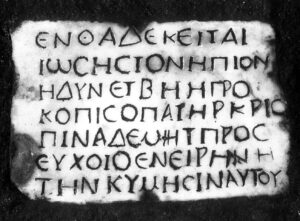
Detail of a marble inscription found in the Catacombs of Vigna Randanini (Frey #126, Noy #282). In Greek: "Here lies Joses, the sweet child, aged 2 years, 8 days. Procopius, his father, and Crispina, his mother. May you pray that in peace be his sleep" (DAPICS n. 3137).
Another epitaph from the Monteverde cemetery honoring multiple individuals reads thus: "Here lies Proculus, twice Archon, and his wife, Euodia; Julia. aged 9 years and 9 months, Sabatis, [aged] 9 years, Euodia, [aged] 2 years and 9 months. In peace".[xlviii] It may not be that all were interred in one grave, but, rather, the tablet marked a certain space within the site reserved for the family. Leon discerned a menorah in the lower right hand corner of this inscription that Fr. Frey did not record in the CIJ 1. Other sad testaments to a high rate of child mortality in Rome are documented in the epitaphs to members of the family of one Procopios, all buried in the Vigna Randanini Catacomb. He and his wife, Crispina, bury their son, Joses, who lived for 2 years and days;[xlix] an infant named Maria likely is of the same family;[l] lastly, Procopios buries his spouse, whose epitaph records that she was "diligent, lover of the Law".[li]
Converts to Judaism record their sense of belonging to a local Jewish community. A child that seems not to have been born Jewish, but adopted by Jews, is Irene, a "proselyte", and "Israelite", the second attribute, in fact, not at all common to cite.[lii] The situation for Irene's unusual story is not clear: perhaps, being female, she was not wanted by her birth parents, and was converted to Judaism by her adopted parents.[liii] Another compelling story of adoption is recorded more elaborately in a poetic lament of an adoptive father, Theodotos, to his son, Iustus: "Would that I who reared you, Iustus, my child, were able to place you in a golden coffin. Now, Lord (grant) in thy righteous judgment that Iustus, an incomparable child, may sleep in pace. Here I lie, Iustus, aged 4 years, 8 moths, sweet to my foster father. Theodotos, the foster father to his most sweet child".[liv] As testified in sites all around the Mediterranean, the name Iustus was popular among Jews of this period, appearing frequently in the Talmud as well. It could be a Latinization of the Semitic Zadok, and that of Theodotos, also not uncommon, possibly a Greek form of the Hebrew Nathan or Jonathan.[lv] The direct invocation to the Lord is unusual in Jewish inscriptions of Rome, although there are examples of this elsewhere, as at Beth She'arim. The concept of judgment, like the beliefs in immortality and resurrection, is not uncommon, and can be seen as graphically represented in Christian examples from the catacombs and perhaps inferred as well in epitaphs to Jews.
The touching manifestation of parental grief is reminiscent of the epigram of another Iustus, who was entombed in a mausoleum at Beth She'arim, and who also addressed the living in the manner of the Ancient Greeks on their tombstones. Greek phraseology is evident in both these epitaphs to Jews.[lvi]
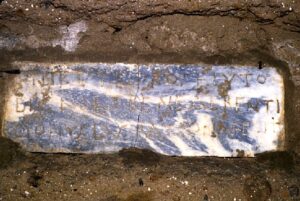
Marble inscription in the Catacombs of Vigna Randanini, Rome (Frey #256, Noy #218). In Latin: "Nikete proselyto digno et benemerenti Dionysias patrona fecit." "To Nicetas, a proselyte worthy and well-deserving, his patroness Dionysias set up (this stone) (DAPICS n. 0224).
The Jewish cemeteries of Rome contained both proselytes and metuens, the latter apparently "God-fearing" Judaizers who observed only some of the Jewish practices.[lvii] Various catacombs housed their tombs, though it is not clear if certain areas were designated for community members in these categories. Included among the converts are Cresces Sinicerius, "a Jew and proselyte" in the Villa Torlonia catacomb;[lviii] Nicetas, a proselyte, also described as "patroness" to a certain Dionysias,[lix] and Felicitas, a proselyte to Judaism at a mature age, named (or renamed?) Peregrina, whose unnamed patron set up the tombstone.[lx] Possibly the story behind this stone is that Felicitas was a freed slave who assumed the name Peregrina as her second name (or, indeed, Jewish name, as "Peregrina" is the female equivalent of the Hebrew word for proselyte of which the literal translation is "foreign" or "alien", as is the Latin "Peragrina"), and her former patronus, knowing her background, was responsible for setting up the epitaph in her honor.[lxi]
To the best of our current knowledge, there are more female proselytes than male ones recorded in the Jewish catacombs of Rome. This might be due in part to the difficulty entailed by men to submit to the Biblical covenant made between the Lord and Abraham: "This is my covenant which ye shall keep, between me and you and thy seed after thee. Every man child among you shall be circumcised" (Genesis, 17:10). Circumcision, a rite known to have been practiced since the third millennium BCE, had been proscribed by the Emperor Hadrian for all, including Jews, and the continuation of this decree in force for non-Jews during the reign of Antoninus Pius (although by this point Jews could resume the practice), would have had a limiting effect on the number of male converts to Judaism. The higher ratio, however, of known female proselytes could also be an accident of discovery.[lxii]
Other noteworthy epitaphs, of interest for various reasons, are as follows:
"D [...] to Fofotis, his son, in grateful memory, who lived 2 years, 7 months. In peace his sleep".[lxiii] If the letter "D" represents the standard polytheistic formula Dis Manibus, this invocation to the Roman gods of the underworld is a curious introduction to an epitaph to a Jew. Then, again, the initial letter or letters might have been cut for another commission, or, for the purchaser, was not a cause for concern.
Other epitaphs use original, or stock humor: one, simply reading "Salpingius, a child", [lxiv]employs a clever pun on the name of Salpingius, which is derived from the Greek term salpnix, trumpet, by adding motifs of trumpets - shofars? - to emphasize the point.
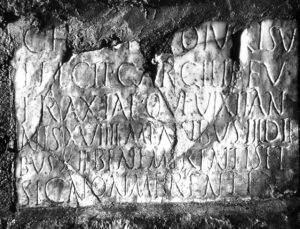
Inscription from the Catacombs of Vigna Randanini, Rome (Frey #237, Noy #258). In Latin, "Ch(…) coiugi sue fecit Gargilie Eufraxiae que vixit annis XVIIII mensibus III diebus XII benemerenti set sic non merenti" " Ch(…)set up (this stone) to his wife, Gargilia Eufraxia, who lived 19 years, 3 month, 12 days, well deserving, but not deserving this" (DAPICS n. 3151).
A man whose name is mutilated on the stone conserved today in the Vigna Randanini catacomb, makes a play on words in the epitaph in Latin to his wife, Gargilia Eufraxia, identifying her with the most common term employed in Roman epigraphic habit, "well deserving" (benemerenti), "but not deserving this".[lxv] Even more flippant is the epitaph in Latin of one Leo, written in the first person, to remind visitors of the inevitable: "I await you here".[lxvi] Not all scholars have been prepared to accept such sentiments in a Jewish context! But, like the occasional D.M., it points to epigraphic habits which served a common market, not for Jews alone, like so much of actual catacomb creation and embellishment.
[i] The earliest documented Jewish epitaphs from ancient Rome (CIJ 1.503; JIWE 2.549, pp. 431-433; and CIJ 1.523; JIWE 2.577, pp. 457-459), no longer extant, were recorded in the sixteenth century by Philippe de Winghe (d. 1592) before the first publication of a Jewish catacomb (Monteverde) by Antonio Bosio in 1632-1634, c.f. H. J. Leon, Jews of Ancient Rome (Philadelphia: Jewish Publication Society, 1960), pp. 67-68.
[ii] P. Testini, Le Catacombe e gli antichi cimiteri cristiani in Roma (Bologna: Cappelli editore, 1966), p. 194.
[iii] Besides the epitaphs from the catacombs, there were also inscriptions from other sites in Rome or without any provenance. Among these also were some epitaphs which were bilingual or included Hebrew phrases or Jewish symbols (cf. JIWE 2, nn. 535, 539, 545, 550, 551, 560, 564, 577).
[iv] Leon, Jews of Ancient Rome, pp. 242-244; L. V. Rutgers, The Jews of Late Ancient Rome: Evidence of Cultural Interaction in the Roman Diaspora (Leiden-Boston: Brill, 1995), pp. 140-143.
[v] Particularly critical of Leon's previous study on this issue: Rutgers, Jews in Late Ancient Rome, p. 143.
[vi] These statistics are often taken as an indication of the degree to which the Jews of ancient Rome had become integrated into their surroundings: Leon, Jews of Ancient Rome, pp. 93-121 and Rutgers, Jews of Late Ancient Rome, pp. 139-175, for detailed studies on the names of Jews in Rome.
[vii] CIJ 1.497; JIWE 2.539, pp. 422-423.
[viii] In all its variations, the closing formula calling for peace (in the hereafter) is fairly common in both Jewish and Christian epitaphs and appears in pagan texts. In Christian and pagan inscriptions, it is generally written in Latin, and in Jewish epitaphs, usually expressed in Greek, with rare instances in Hebrew.
[ix] Rutgers, Jews of Late Ancient Rome, pp. 155-157.
[x] Leon, Jews of Ancient Rome , pp. 112-113.
[xi] CIJ 1.212; JIWE 2.377, p. 117.
[xii] Many of the Jewish slaves brought to Rome as prisoners of war by Pompey, Vespasian, and Titus, were eventually freed by their Roman masters or had their freedom purchased with funds provided by their co-religionists, who regarded freeing them as a duty: Leon, Jews of Ancient Rome, pp. 237-238.
[xiii] Leon, Jews of Ancient Rome, p. 118, note 3.
[xiv] CIJ 1.72; JIWE 2.616, pp. 498-500.
[xv] CIJ 1.470; JIWE 2.618, pp. 501-503.
[xvi] CIJ 1.72; JIWE 2.616, pp. 498-500. Leon was not convinced that Julia was Jewish, but included her epitaph in his list in Jews of Ancient Rome, pp. 113, 247, 273-274, no. 72. R. Lanciani, New Tales of Old Rome (Boston: Houghton & Mifflin, 1901), pp. 242-243, Frey, CIJ 1, pp.44-46, and B. Lifshitz, in Prolegomenon to CIJ 1, pp. 27-28, identified her as a Jew. D. Noy placed this epitaph in Appendix 4 of the JIWE 2, pointing out that "nothing [in the inscription] cannot be satisfactorily explained as Christian" and that A. Ferrua had considered it to be Christian.
[xvii] CIJ 1.470; JIWE 2.618, pp. 501-503; Latin, 2nd-3rd century (?). The epitaph, now in the Vatican Museum, was assembled by N. Müller from fragments supposedly from the Monteverde Catacomb; it is very worn and its interpretation not totally clear. Noy placed it in JIWE 2, Appendix 4, finding aspects inconsistent with Jewish usage. He added that the inscription may be "a reused pagan one," ... [and the] "nature of the plaque and the form of the epitaph ... unparalleled at Monteverde."
[xviii] Leon, Jews of Ancient Rome, p. 120.
[xix] CIJ 1. 523; JIWE 2.577, pp. 457-459; Leon, Jews of Ancient Rome, p. 254.
[xx] S. Grayzel, A History of the Jews, from the Babylonian Exile to the End of World War II (Philadelphia, 1947), p. 140; M. Grant, The Jews in the Roman World (New York, 1973), p. 60.
[xxi] CIJ 1.370; JIWE 2.112, p. 95; Leon, Jews of Ancient Rome, p. 319.
[xxii] JIWE 2.25; CIJ 1.358.
[xxiii] "Ionios, who [was] also [called] Akone, of Sepphoris" (possibly Jonas is meant): CIJ 1.362; JIWE 2.60, p. 53; Leon, Jews of Ancient Rome, p. 318, fig. 39, no. 23.
[xxiv] "Here lies Irene, a virgin": CIJ 1.320), JIWE 2.59, p. 52; Leon, Jews of Ancient Rome, p. 312.
[xxv] "Alypius of Tiberias and his sons, Justus and Alypius, Hebrews, with their father, lie here": CIJ 1.502; JIWE 2.561, pp. 445-446; Leon, Jews of Ancient Rome, p. 338. Noy dated this inscription "2nd-4th century (?)," but added that, "The historian Justus of Tiberias was a contemporary of Josephus." (CIJ 1.502; JIWE 2.561, pp. 445-446, translated as "Alypi(o)s of Tiberias and his sons, Iustus and Alypi(o)s, Hebrews, lie here with their father"; now in the Terme Museum Epigraphic collection).
[xxvi] In her documentation of a first century C.E. tomb in Jericho used by three generations of one family, possibly one of priests, R. Hachlili observes that to name a son after his living father seemed to prevail "during this period among the Jewish priesthood and aristocracy, especially in the families of the high priests and the Herodian dynasty." Originally it was a foreign custom used by Hellenistic royal dynasties, and it was evidently adopted by the Jews, Hachlili, "The Goliath Family in Jericho," in Bulletin of the American Schools of Oriental Research 235 (1979), pp. 53 and 58.
[xxvii] CIJ 1.296; JIWE 2.183, pp. 145-146. Ammias was a common name in Asia. The translation of the last phrase of her epitaph as "peace" (in Hebrew, " shalom ") has been debated, with some earlier scholars identifying the script as Nabataean or Palmyrene, according to Noy, but he observed that the characters "show close similarities to the Hebrew at Beth She'arim": ibid . p. 146; Leon, Jews of Ancient Rome, p. 308. CIJ 1.296; JIWE 2.183, pp. 145-146. In his JIWE commentary, Noy, p. 146, finds Ammias a common name in Asia, and sees close similarities in the Hebrew lettering to inscriptions at Beth She'arim. Leon, in Jews of Ancient Rome, p. 239, believes Syria is the more likely homeland.
[xxviii] CIJ 1.408; JIWE 2.113, p. 96; Leon, Rome , pp. 153-154, 326.
[xxix] See Leon, Jews of Ancient Rome, pp. 153-154, and Frey, CIJ 1, pp. lxxviii-lxxix.
[xxx] Inscriptions CIJ 1. 129; JIWE 2.237; CIJ 1.147; JIWE 2.238, 239; CIJ 1.167; JIWE 2.239; pp. 209-211; Leon, Jews of Ancient Rome, pp. 283, 286, 289. R. Garrucci, Cimitero degli antichi Ebrei scoperto recentemente in vigna Randanini (Rome: La Civilta' Cattolica, 1862), pp. 62-63, recorded the epitaphs of Centulia and Ursacia along with a third inscription in the same cubiculum. When Marucchi explored the cubiculum later, he recorded only Ursacia's epigraph and that of Honoratus, son of Rufus the archon: O. Marucchi, Breve guida al cimitero giudaico di Vigna Randanini (Rome, 1884), p. 241. But Garrucci, p. 61, had initially found young Honoratus buried in a chamber with his grandfather, the elder Honoratus, Rufus's father. Since Marucchi found the grandfather's epitaph separate from his grandson's, some of the inscriptions had evidently been moved from their original sites.
[xxxi] JIWE 1.643, pp. 11-13.
[xxxii] U. M. Fasola, "Le due catacombe ebraiche di Villa Torlonia," in Rivista di Archeologia Cristiana 52 (1976), pp. 25-26, fig. 10; JIWE 2.515, p. 405.
[xxxiii] Fasola, "Torlonia," pp. 25-26.
[xxxiv] Fasola, "Torlonia," pp. 21-22, 23, fig. 9; JIWE 2.508, p. 402.
[xxxv] Fasola, "Torlonia," pp. 46-47, fig. 21; JIWE 2.415, p. 345. Noy suggested that "Abibos" is the Greek form of the Semitic name "Habib."
[xxxvi] G. Migliore, who copied the inscription of Alexandra of Arca of Libanus, presents two conflicting versions: one reading that her father, Alexander, was of the city of Ara and another suggesting that he was a member of the synagogue of Arca. Frey, in the CIJ 1, pp. lxxix-lxxxi, believes that the synagogue is referred to, while Leon, Jews of Ancient Rome, pp. 163-165, states that there is no firm evidence of this and Arca could as easily be the city - he also points out that there is no specific attribution of this inscription to Rome. JIWE 2.290, in Aramaic, might identify an Annia from Calabria (E. Brettman notes that Frank Moore Cross suggested Annia as a Grecizing form of Hanniya (conversation of 10/20/1984), and Dr. Murray Tuchman corroborates this while suggesting that the name could refer either to a female, Haniya or Hanniya, with variations, or to a masculine name like Hanina or Hanan (conversation with E. Brettman of 08/27/1990).
[xxxvii] CIJ 1.106; JIWE 2.321, pp. 268-269, from Monteverde, now in the National Roman Museum Epigraphic Collection. Lazar, according to Frey, could be the common Hebrew name Eleazar.
[xxxviii] CIJ 1.72; JIWE 2.616, pp. 498-499, now a fountain basin in the courtyard of Palazzo Spada in Rome and classified by Noy among the inscriptions "not considered Jewish".
[xxxix] Fasola, "Torlonia," p. 46, fig. 20.
[xl] CIJ 1.31; JIWE 2.457, pp. 371-372, from Monteverde, now in now in the National Roman Museum Epigraphic Collection.
[xli] CIJ 1.263; JIWE 2.220, p.196, written in Latin; current whereabouts unknown.
[xlii] CIJ 1.344; JIWE 2.123, p. 104.
[xliii] CIJ 1.248; JIWE 2.335, pp. 280-281.
[xliv] M. Schwabe and B. Lifshitz, Beth She'arim, 2: The Greek. Inscriptions (New Brunswick, N.J.: Rutgers University Press, 1974), p. 97, n. 127.
[xlv] CIJ 1.304; JIWE 2.69, pp. 60-61.
[xlvi] CIJ 1.35*; JIWE 2.105, pp. 89-90.
[xlvii] JIWE 2.418, p. 351. Inconsistently, the correct form of the numerical three was used to modify the noun "years" only in its second usage.
[xlviii] CIJ 1.270; JIWE 2.391, p. 325.
[xlix] CIJ 1.359; JIWE 2.126, p, 106.
[l] CIJ 1.447; JIWE 2.137, pp. 113-114.
[li] CIJ 1.431; JIWE 2.132, p. 111.
[lii] CIJ 1.21; JIWE 2.489, pp. 390-391, in the lower level of the Villa Torlonia catacomb.
[liii] Other references to adoption in JIWE 2 nn. 3, 144, and 358, with commentary on the custom of adoption during this period, not uncommon among Jews in Frey, CIJ 1. p. 279, and B. Liftshitz, Prolegomenon to CIJ 1, p 34.
[liv] CIJ 1.358; JIWE 2.25, pp. 28-30, from the Monteverde cemetery. Different interpretations have been given of this epitaph. The format used here is from Leon, Jews of Ancient Rome, pp. 317-318, who argues that the lack of space on the stone forced the stonecutter to carve the remainder of the body of the text on the right side of the stone and the tender closing dedication on the other side. See also A. Ferrua, "Sulla tomba dei cristiani e su quella degli ebrei," in Civilta' Cattolica 87.4 (1936), p. 299.
[lv] Leon, Jews of Ancient Rome, p. 121.
[lvi] Schwabe and Lifshitz, Beth She'arim, 2, pp. 97-110.
[lvii] Leon, Jews of Ancient Rome, p. 74, n. 1.
[lviii] CIJ 1.68; JIWE 2.491, pp. 392-393, where Noy points out that the phrase "took his sleep" or dormitione accepit is common in pagan epitaphs in Italy, as in the inclusion of the date; for whatever reason, the family members who commissioned the work did not adopt the Jewish epigraphic style.
[lix] CIJ 1.256; JIWE 2.218, pp. 194-195.
[lx] CIJ 1.462; JIWE 2.62, p. 375.
[lxi] Leon, Jews of Ancient Rome, pp. 254, n. 2 and 337; for a diverse opinion on Felicitas' history, see CIJ 1, p. 341.
[lxii] Leon, Jews of Ancient Rome, pp. 255-256: there are six, and possible seven references, if the fragmentary inscription, CIJ 1.202; JIWE 2.392, pp. 325-326, found in the Vigna Randanini site, does, in fact, refer to a proselyte.
[lxiii] CIJ 1.65; JIWE 2.464, p. 376, Monteverde catacomb.
[lxiv] CIJ 1.405; JIWE 2.162, p. 129.
[lxv] CIJ 1.237; JIWE 2.258, pp. 227-228.
[lxvi] CIJ 1.32*; JIWE 2.104, pp. 88-89. Frey did not consider this epitaph as Jewish because of its "ironic tone". but many others have found no problem in seeing it in a Jewish context, especially since, as Noy observes, "Lion names were popular among Jews because of associations with the 'Lion of Judah', JIWE 2, pp. 88-89.
